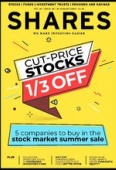Archived article
Please note that tax, investment, pension and ISA rules can change and the information and any views contained in this article may now be inaccurate.
Where to start with investing in metals and energy products via ETFs

Commodities, which cover everything from oil to copper to corn, play a central role in our lives. They fuel the cars we drive, line the cables which keep us online and some are in the meals we eat.
Investing in this space used to be the preserve of the professionals but several developments, most notably the emergence of exchange-traded funds (ETFs), have enabled ordinary investors to get in on the act.
ETFs track a certain index to mirror its performance. For example, if you buy a silver ETF, it should move up and down in line with the movement of the precious metal.
DEMOGRAPHICS UNDERPIN COMMODITIES
An increasing global population and the finite nature of many commodities underpins these markets over the long term.
However, while some commodities exposure could be a good fit for a balanced portfolio there are several factors you need to consider if you want to buy a commodity-based tracking product, such as diversification.
Products focused on a single commodity, with the possible exception of gold, are only appropriate for more sophisticated investors, particularly as the individual markets can see considerable volatility.
Instead it could be more sensible to start off with an ETF which tracks a large basket of different commodities. An example includes Invesco Bloomberg Commodity (CMOD). However, not all broad commodities indices are created equal and some will be dominated by the larger commodity markets such as oil.
The methodology behind the Bloomberg Commodity Index, for example, seeks to address this situation by adjusting the index weighting to ensure no single commodity dominates the index. In comparison, the S&P GSCI index has an energy products weighting of more than 60%.
WHAT IMPACT DOES THE FUTURES MARKET HAVE?
A further consideration, which applies particularly to long-term investors, is the impact of the futures market phenomena ‘contango’ and ‘backwardation’. Over time these can have a material impact on returns.
Most commodities are traded in futures contracts. This is the purchase or sale of a commodity agreed at a fixed price for delivery on a specified date – typically either one month, three months or six months ahead.
This facilitates the buying and selling of the respective commodity without anyone having to take physical delivery of a barrel of oil or bushel of corn, for example. Only a tiny fraction of these contracts are settled through deliveries, the bulk are instead ‘rolled over’ to the next month and the pattern repeated.
Contango refers to the market condition whereby the price of a futures contract in a commodity is trading above the spot price (the current market price). The resulting futures ‘curve’ would be upward-sloping with prices for dates further in the future trading at ever higher levels.
Backwardation describes the reverse – where futures are trading below the spot price – often because of short-term tightness in the underlying market. Arguably contango is a more natural state as it reflects costs of ownership such as storage and insurance.
COST OF THE ROLL
What does this mean for an investor? When contracts are rolled over to avoid taking delivery of the physical asset, contango sees returns diminished, also known as ‘negative roll yield’. Meanwhile, backwardation sees returns enhanced due to the ‘positive roll yield’.
The impact of contango is more acute for investors because the providers of these products do not pay a premium every month to cover the cost of the ‘roll’ and maintain the same position.
In effect the instrument is giving up a proportion of its position to cover the cost of the roll-over.
WisdomTree research director Nitesh Shah says: ‘Most industrial metals have a flat futures curve while precious metals have negligible or no contango or backwardation. Energy markets tend to see more pronounced contango or backwardation. Currently oil is in backwardation but it had been in contango for some time before that.
‘Other markets are very seasonal such as natural gas and lean hogs and you will see that reflected in the futures curve.’
AN OPTIMISED APPROACH
By adopting different strategies, some products and indices seek to provide a solution to this problem. These so-called ‘optimised solutions’ will typically look to buy a selection of different futures contracts to mitigate the negative impact of contango and, in some cases, maximise the positive impact of backwardation.
There are several UK-listed ETFs which fall into this category. Among them are UBS ETF CMCI Composite (UC15), WisdomTree Enhanced Commodity (WCOG) and iShares Bloomberg Roll Select Commodity Swap (ROLL).
WisdomTree’s Shah believes you need to think carefully about what you are buying and not look to invest in the commodities product with the lowest fee. ‘You can’t just look at the name; you really need to study the prospectus carefully in order to make an informed decision.’
WHICH COMMODITIES COULD GO UP IN PRICE?
A recent piece of research by investment bank Morgan Stanley identified several bright spots, namely copper, palladium and tin.
Morgan Stanley believes supply issues could support copper prices and an example of an ETF tracking the base metal price is ETFS Copper (COPA).
It sees continued upside in palladium prices until mid-2020. Demand currently outweighs supply, which is pushing up the price. Invesco Physical Palladium (SPAP) is among the ETFs tracking the value of the metal.
In the long term tin is expected to be a beneficiary of new technology development with the metal widely used in solders. To quote consultancy Roskil it is the metal which ‘glues the technology revolution’. Exposure is possible through such ETFs as ETFS Tin (TINM).
Important information:
These articles are provided by Shares magazine which is published by AJ Bell Media, a part of AJ Bell. Shares is not written by AJ Bell.
Shares is provided for your general information and use and is not a personal recommendation to invest. It is not intended to be relied upon by you in making or not making any investment decisions. The investments referred to in these articles will not be suitable for all investors. If in doubt please seek appropriate independent financial advice.
Investors acting on the information in these articles do so at their own risk and AJ Bell Media and its staff do not accept liability for losses suffered by investors as a result of their investment decisions.

 magazine
magazine










